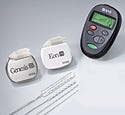005: Buy! Buy! Buy!
Originally Published MDDI February 2006WHO DID WHAT IN 2005 It was a busy and controversial year for the movers and shakers in the device industry, and it seemed like one company was at the center of the biggest stories: Indianapolis-based Guidant Corp.
February 1, 2006
WHO DID WHAT IN 2005
|
It was a busy and controversial year for the movers and shakers in the device industry, and it seemed like one company was at the center of the biggest stories: Indianapolis-based Guidant Corp.
The year began with buzz about Johnson & Johnson (J&J; New Brunswick, NJ) making a $25.4 billion offer to buy Guidant, which would have been the biggest deal in the history of the device industry and create by far the largest company in the sector. At the time, the biggest intrigue was whether the deal would pass regulatory muster.
By May, a whole new angle came into play. Some of Guidant's implantable cardioverter-defibrillators—one of the technologies J&J was very interested in—were found to have short-circuited, and doctors and patients had not been warned. FDA had been informed, but hadn't taken action. The drug center was already under fire, and to the agency's critics in Congress and the public, the incident meant that maybe CDRH shared some of the same problems. The Guidant issue was one impetus behind extensive postmarket-related reforms at CDRH, which will affect regulatory compliance for a vast array of device firms.
|
In the fall, the deal received a seal of approval from regulators, but J&J started having buyer's remorse. It announced its intention to back away from the deal, but Guidant sued to force its completion. In November, the firms reached a compromise: The deal would go through at a reduced price of $21.5 billion.
The main reason J&J made a play for Guidant was its desire to get into the lucrative cardiac rhythm management (CRM) market. One of J&J's rivals in the cardiovascular field, Boston Scientific Corp. (Natick, MA), doesn't have a presence there either. In December, Boston Scientific shocked the industry by announcing its intention to make a play for Guidant, to the tune of $25 billion. Why would it bid up a company that its rival apparently considered damaged goods? Because CRM technology is just that coveted, and since there are only three firms that have it, the opportunities for market entry are limited.
|
At the start of 2006, Boston Scientific and J&J demonstrated their ardor for Guidant's technology by raising their bids, with Boston Scientific emerging as the apparent winner when it raised its offer to $27 billion. The completion and integration of this deal, and what J&J might decide to do next, should make two of the biggest stories of 2006.
Other corners of the device industry were active in 2005 as well. The immense interest in neuromodulation technology came to the fore again. One year after Boston Scientific paid a mint to buy Advanced Bionics Corp. (Valencia, CA), St. Jude Medical (St. Paul, MN) bought Advanced Neuromodulation Systems Inc. (Plano, TX). The $1.3 billion deal was the largest one consummated in the device industry in 2005.
And the ophthalmics market showed heated activity. The second-, third-, and fourth-largest device industry 2005 deals all involved ophthalmic companies swallowing up rivals. Each was done for different reasons, but the underlying theme was bringing new core competencies to the buyer. Strong activity in other areas, from imaging to reprocessing, was seen also.
All of which, despite the occasional turbulence, paints a healthy picture of the device industry. Investments in innovative technologies from large companies, venture capitalists, and smaller investors means those who control the flow of money into the sector are liking what they see. The following stories mostly confirm their optimism.
You May Also Like



.png?width=300&auto=webp&quality=80&disable=upscale)

